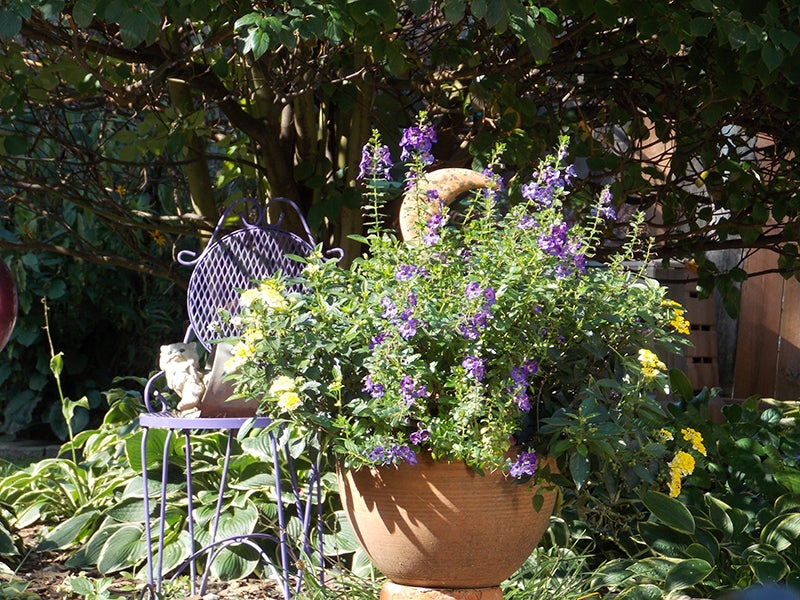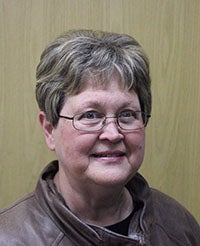Serendipity Gardens: Small spaces can provide a challenge
Published 9:00 am Saturday, April 13, 2019

- An elevated container can create a focal point. The flowers in the pot even match the purple chair next to it. - Carol Hegel Lang/Albert Lea Tribune
Serendipity Gardens by Carol Hegel Lang
Carol Hegel Lang is a green thumb residing in Albert Lea. Her column appears bimonthly. Email her at carolhegellang@gmail.com.
Gardening in small spaces can be a challenge when you love to garden and every plant you see at the garden center is calling your name. Most of the time I try to control my impulse purchases, but on occasion, that special plant jumps out at me, begging me to take them home, and I break down my resistance and purchase it.
If you have visited my Serendipity Gardens you know my gardens are small. Even though there are 13 of them, none of them are big enough to suit me, so I tend to pack a lot of plants and small trees and shrubs in them.
Another hindrance is that I do not have a lot of full sun, so most things have to be able to survive with limited light.

Carol Hegel Lang
Vegetable gardening has always been a real challenge for me because of the amount of light that my gardens have, but I have learned to be very resourceful so that I can grow tomatoes, peppers and green beans. Elevating the plants to get more sunlight has solved the problem for me. My tomato and pepper plants are perched on top of lawn chairs stacked four high, and by using a rain barrel they receive enough sunlight to produce nicely for me. Luckily green beans will tolerate a fair amount of shade, so they can be grown at ground level. I love growing veggies in containers, and luckily they have really stepped up to the plate with varieties that will grow well in containers. My pepper plants produced an abundance of sweet ones that I froze and am still enjoying in April.
Even in the flower garden I elevate containers to maximize sunlight or add height to the gardens. My cement bench deteriorated enough that it was no longer safe to sit on, so we took off the broken base, added a couple of cement blocks and now it has become a place for me to put containers — adding not just height, but covering the boring cedar fence with color. Another trick I use is to turn containers upside down and then place a larger container on top of it so I can add an accent plant. For me, adding depth or an accent is very important in these small gardens. Along the back gate I have three containers stacked on top of each other to put them above the containers that sit on the ground in front of them. I also use cannas for height in containers and elephant ears to give me a wow factor.
My gardens along the fence are raised beds, and in them the challenge is providing color against the gray fence along with interest. The gardens are very small — about 6-feet-wide by 4-feet-deep — so the soil has to be very good to sustain the number of plants I have in them, as well as retain water so they don’t dry out too quickly. The fence draws heat and some of them are in full sun. Joe-pye weed, rudbeckia, daffodils (for early spring), daylilies, phlox and morning glories seem to work very well in these beds. In the ones that have nearly full shade I have made a wildflower garden that blooms mainly in spring, with a sweet autumn clematis climbing up the fence for height and to hide the fence. Planted at ground level in front of this bed are hosta, more rudbeckia, phlox and invincible spirit hydrangea.
Maximizing space, adding color and starting with good soil are the key elements of these gardens, and using annuals for added emphasis. The pollinator garden was developed over a span of five years and added on three times. Native plants, annual zinnias, cosmos, bachelor buttons, marigold and a shrub to anchor the bed give it the impression that it is much larger than it is by adding tall flowers for more height.
“Our role as a flower gardener is about more than making the world beautiful. It’s also about doing whatever we can to reduce our negative impact on the earth and help preserve biodiversity.” — Kathleen LaLiberte, Longfield Gardens


